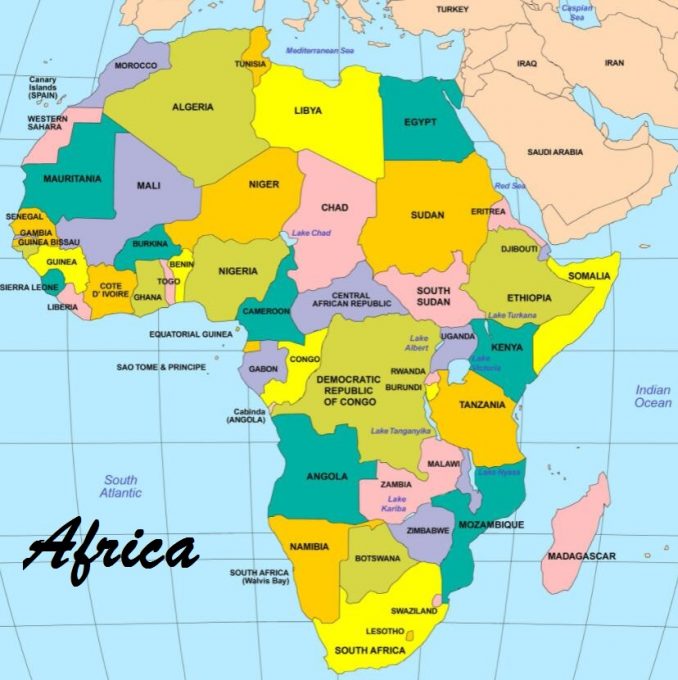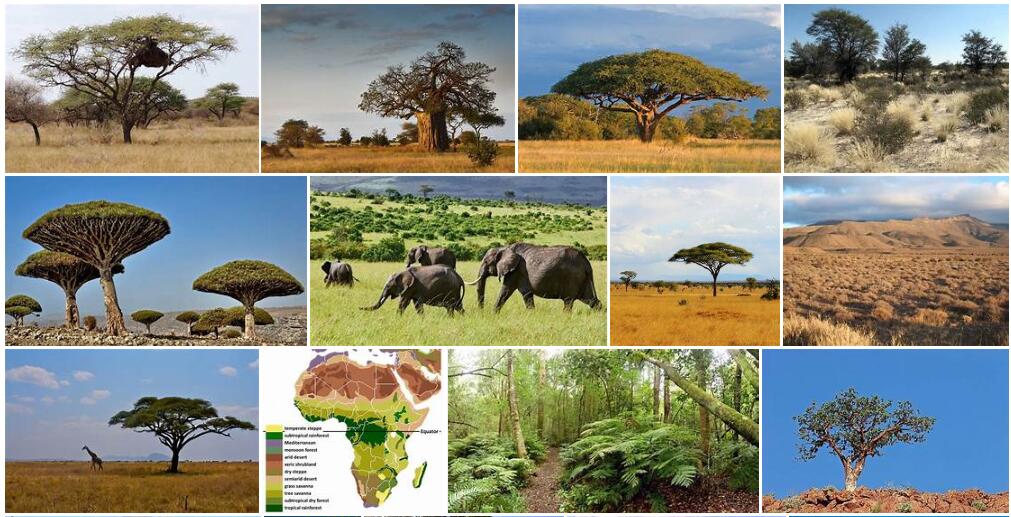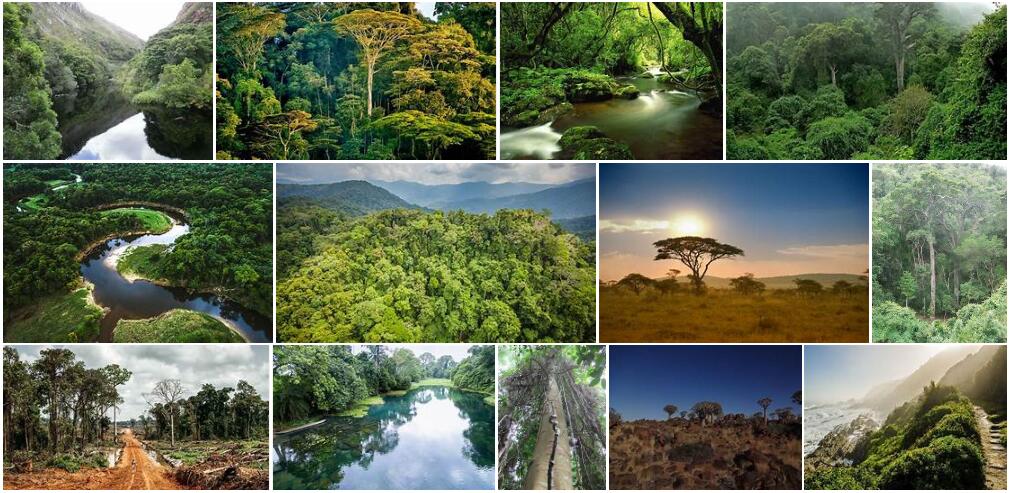Africa is the third largest part of the world with 30 million square kilometers – it makes up around 22 percent of the total country area of the world. It extends from 37 ° north latitude to 34 ° south latitude.
Geography
Africa is a land mass that is not very subdivided by indentations of the sea and is separated from Europe by the Mediterranean Sea , the Red Sea and the Suez Canal from Asia. Africa has a barely structured coast and few good ports.
The African continent is characterized by numerous different landscapes: the great desert landscape of the Sahara connects to the Atlas, the young fold mountains in the northwest. This is limited in the south by the Sudan basin. Basin landscapes and highlands lie in the southern part of Africa, and in the east also with rifts and volcanoes: Here lies the famous Kilimanjaro. The Cape Fold Mountains finally rise in the far south.
Large streams such as the Nile, Congo, Zambezi and Niger flow in the vast basins of the African continent. In East Africa there are also large lakes such as Lake Victoria, Lake Tanganyika or Lake Malawi.
Climate and vegetation
A distribution of the climate zones starting from the equator to the north and south is relatively uniform. The climate near the equator is tropical. Here you can find dense jungle with rain in all seasons. Subtropical regions adjoin the tropical rainforest to the north and south, which merge into tree grass steps, which are characterized by the alternation of rainy and dry seasons. These areas are followed by the continent’s large arid regions in the north and south. In the dry regions there are grass plains and deserts (Kalahari, Sahara). Finally, there is a Mediterranean climate on the north and south coast of Africa. In the areas of the Atlas there are hardwoods, maquis and olive trees.
The animal world is very diverse: monkeys, elephants, hippos, crocodiles, snakes, lizards, birds and insects live in the jungle, antelopes, ostriches, giraffes, lions, elephants, rhinos, jackals, hyenas and leopards etc. live in the steppes.
| Country | Average temperature / day |
| Algeria | Algiers 15 ° C (Jan), 29 ° C (July) |
| Angola | Luanda 31 ° C (March), 24 ° C (Aug) |
| Benin | Porto Novo 28 ° C (Jan), 26 ° C (July) |
| Botswana | Gaborone 26 ° C (Jan), 13 ° C (July) |
| Burkina Faso | Ouagadougou 32 ° C (April), 25 ° C (Jan) |
| Burundi | Bujumbura 24 ° C (Jan), 22 ° C (July) |
| Central African Republic | Bangui 32 ° C (Jan), 21 ° C (July) |
| Comoros | 23–28 ° C all year round |
| Djibouti | 36 ° C (July), 25 ° C (Jan) |
| Egypt | Cairo 28 ° C (July), 13 ° C (Jan) |
| Equatorial Guinea | Malabo 27 ° C (Feb), 25 ° C (July) |
| Ivory Coast | Abidjan 27 ° C (Jan), 24 ° C (July) |
| Eritrea | Asmara 26 ° C (June), 22 ° C (Dec) |
| Ethiopia | Addis Ababa 18 ° C (May), 15 ° C (Nov) |
| Gabon | Libreville 23–31 ° C (Jan), 20–28 ° C (July) |
| Gambia | 19 ° C (Jan), 28 ° C (June) |
| Ghana | Accra 24 ° C (Aug), 23 ° C (March) |
| Guinea | Conakry 28 ° C (April), 25 ° C (Aug) |
| Guinea-Bissau | Bissau 27 ° C (July), 24 ° C (Jan) |
| Cameroon | Yaoundé 24 ° C (Jan), 23 ° C (July) |
| Cape Verde | Sal 21 ° C (Feb), 27 ° C (Sept) |
| Kenya | Nairobi 21 ° C (March), 17 ° C (July) |
| Congo-Brazzaville | Brazzaville 26 ° C (Jan), 23 ° C (July) |
| Congo-Kinshasa | Kinshasa 27 ° C (April), 22 ° C (July) |
| Lesotho | Maseru 25 ° C (Jan), 15 ° C (July) |
| Liberia | Monrovia 27 ° C (March), 25 ° C (July) |
| Libya | Tripoli 26 ° C (Aug), 12 ° C (Jan) |
| Madagascar | Antananarivo 21 ° C (Jan), 15 ° C (July) |
| Malawi | Lilongwe 23 ° C (Jan), 16 ° C (July) |
| Mali | Bamako 27 ° C (July), 24 ° C (Jan) |
| Morocco | Discount 13 ° C (Jan), 22 ° C (July) |
| Mauritania | Nouakchott 22 ° C (Jan), 28 ° C (July) |
| Mauritius | 28 ° C (Jan), 21 ° C (July) |
| Mozambique | Maputo 26 ° C (Jan), 18 ° C (July) |
| Namibia | Windhoek 25 ° C (Dec), 13 ° C (June) |
| Niger | Niamey 37 ° C (April), 25 ° C (Dec) |
| Nigeria | Lagos 28 ° C (March), 24 ° C (Aug); Abuja 30 ° C (March), 25 ° C (Aug) |
| Rwanda | Kigali 21 ° C (Jan), 19 ° C (July) |
| São Tomé and Príncipe | Sao Tome 31 ° C (March), 28 ° C (July) |
| Senegal | Dakar 22 ° C (Jan), 28 ° C (Sep) |
| Seychelles | Victoria 27 ° C |
| Sierra Leone | Freetown 28 ° C (March), 19 ° C (July-Aug) |
| Somalia | Mogadishu 28 ° C (March), 25 ° C (August) |
| Sudan | Khartoum 33 ° C (June), 22 ° C (Jan) |
| Swaziland | Mbabane 20 ° C (Jan), 12 ° C (July) |
| South Africa | Pretoria 20 ° C (July), 29 ° C (Jan) |
| South Sudan | 23–34 ° C all year round |
| Tanzania | Dodoma 24 ° C (Jan), 19 ° C (July) |
| Chad | N’Djamena 24 ° C (Jan), 28 ° C (July) |
| Togo | Lomé 27 ° C (Jan), 24 ° C (July) |
| Tunisia | Tunisia 27 ° C (Aug), 11 ° C (Jan) |
| Uganda | Kampala 21 ° C (July), 23 ° C (Jan) |
| Zambia | Lusaka 16 ° C (July), 24 ° C (Oct) |
| Zimbabwe | Harare 28 ° C (Oct), 6 ° C (July) |
Population
The population of Africa is not exactly known. Some of the figures differ considerably. According to Countryaah, the Africa has a population of 906 million (2004). Around six million of these are of European origin. In the north to the middle of the Sahara mainly European races (Arabs, Berbers, etc.) live, in the south mainly negrine races. Asian peoples also immigrated to the east. In the jungle there are still hunter and gathering tribes, while in North, East and South Africa there are more cattle breeders and nomad herders.
Most of the people in North Africa are Muslim. The Christian mission was successful in the other parts of the continent, mostly Christians live here. There are also early Christian communities (Copts) in Egypt and Ethiopia. Other beliefs such as animism, fetishism and totemism are also widespread.
Forests
The African rain forests have supplied large quantities of tropical timber to the European market. Especially on the Guinea coast in West Africa, much rainforest has been cleared. In addition to logging, clearings for plantations, small-scale farming, roads, urban growth and fuel have removed most of the forest. Also in East Africa (Ethiopia, Uganda) and Madagascar, large forest areas have been cleared. In the Democratic Republic of Congo, the largest of the remaining rainforest areas is found (1 million km2).
The deforestation gives way to soil erosion in connection with heavy rainfall and runoff, and certain tropical soil types are converted to gold laterite when exposed to precipitation of iron minerals in the surface.
Most of the energy used for cooking is derived from firewood and charcoal, and in many areas the consumption of wood is greater than the growth of trees. This can also cause erosion problems and spot desertification. As modern energy supply is largely undeveloped in rural and urban slums, it is not possible to replace the fuel with fossil fuels. Several aid projects support the development of renewable energy sources, streamline logging efficiency and tree planting.
The savannah
The savannah areas are home to the large, well-known African mammals such as elephant, giraffe, rhino, zebra and lion. Here, nature is adapted to the change between rainy and dry times. Population growth has meant an initial cultivation of the savannah’s outer areas; plant growth and soil erosion are increased and some animal species are threatened by hunting pressure.
Especially in East Africa, which has a particularly rich animal and plant life, large savannah areas have been protected to counteract these threats. One consequence is that the original residents are excluded, which in particular has caused problems for the nomads when traditional grazing land has been laid out for national parks.
Natural Resources
Minable deposits for the extraction of metalsoccurs in many places in the bedrock that belongs to the African indigenous shield. Most important is the mineral-rich zone from the Shaba province in Congo (Kinshasa) via Zambia and Zimbabwe to South Africa. Copper ore, along with cobalt, dominates in the north, chromium, manganese, gold and platinum in the south. Other assets are iron ore (Liberia, Mauritania, Algeria, Egypt and South Africa), tin (Nigeria, Congo (Kinshasa), Namibia and South Africa), manganese (Gabon), tungsten-lead-zinc (Namibia), uranium (Congo (Kinshasa)) and Namibia) and bauxite (Guinea). In terms of certain metals, Africa accounts for very large proportions of the world’s reserves: chromium over 80%, manganese about 50%, platinum over 80%. Africa is estimated to have about 13% of the world’s copper resources and 30% of the bauxite resources.
Of the other mineable deposits, phosphate and diamond resources are significant (over 70 and 90% of the world’s assets, respectively). Phosphate is found mainly in Morocco and Western Sahara. Congo (Kinshasa), Botswana, Angola and South Africa have large assets of industrial diamonds. Jewelry diamonds can be found in South Africa, Namibia and Congo (Kinshasa).
In total, about 10% of the world’s uranium resources are estimated to be in Africa (Gabon, Congo (Kinshasa), Namibia and South Africa). Other energy resources include oil (Libya, Nigeria, Algeria and Cabinda province of Angola), gas (Algeria and Nigeria) and coal (southern Africa). However, only 1-2% of the world’s coal resources are estimated to exist in Africa, but 9% of the oil resources. Large parts of Africa have good conditions for utilizing solar energy. The rivers also constitute an energy resource; several large power plant dams already exist. However, the often very uneven flow of water in smaller rivers together with the usually large amount of sludge makes the expansion for electricity generation difficult.
Some rivers are important transport routes, e.g. Nile, Niger and Congo. Here too, the uneven water flow and the amount of sludge make the use of smaller rivers difficult. The water hyacinth introduced by man also blocks its progress.
The freshwater resources are very unevenly distributed. Africa has several large rivers and lakes, but 1/3 of the continent is made up of dry areas. Of the groundwater resources, much is brackish or salty, especially in the dry areas. In the Sahara, an aquifer in bedrock formed during chalk contains large amounts of fossil water.
Natural vegetation itself is always a resource or necessity for animals and humans. From an economic point of view, the tropical rainforest and grasslands play the biggest role. The rainforest is mainly found along the Gulf of Guinea (Liberia, Ivory Coast, Cameroon and Gabon) and in the Congo (Kinshasa) and in some of the highland areas of East Africa (mountain rainforest). The forest is a wood, timber and paper pulp reserve. In large felling, replanting occurs, often with foreign tree species, e.g. eucalyptus species. Sometimes the planting takes place too late or not at all, which results in soil erosion and sometimes the formation of hardened soil layers. As the tropical rainforest is poorly studied, one does not know what other resources in the form of proteins, oils, pharmaceutical raw materials etc. that disappear through the harvesting of different species.
The grasslands are of two types: savannas and, in the south, temperate grasslands, e.g. at Veld in South Africa. Both are important as pastures for tambourines. The savannahs also, especially in East Africa, house the world’s species and individual population of wild ungulates. These, together with other wildlife in the savannah environment, in many countries form the basis for great tourism. The ungulates are also an important – mainly potential – protein resource.
Very large parts of the original grasslands are cultivated. With few exceptions, it is in these areas that Africa’s best cultivation lands occur. Although they are mostly of the latosol type, they are less leached here because of the lower rainfall than in the tropical rainforest. The best soil from a nutritional point of view are vertisols, which occur in the east, as well as the alluvial soils along larger rivers and in their delta regions. Intensive cultivation and pickling often cause large areas to suffer from soil degradation, e.g. in the form of gutter and ravine erosion. In large open fields the soil also blows away. In cases where irrigation occurs, salt enrichment is a common phenomenon, e.g. now in the Nile Valley.


